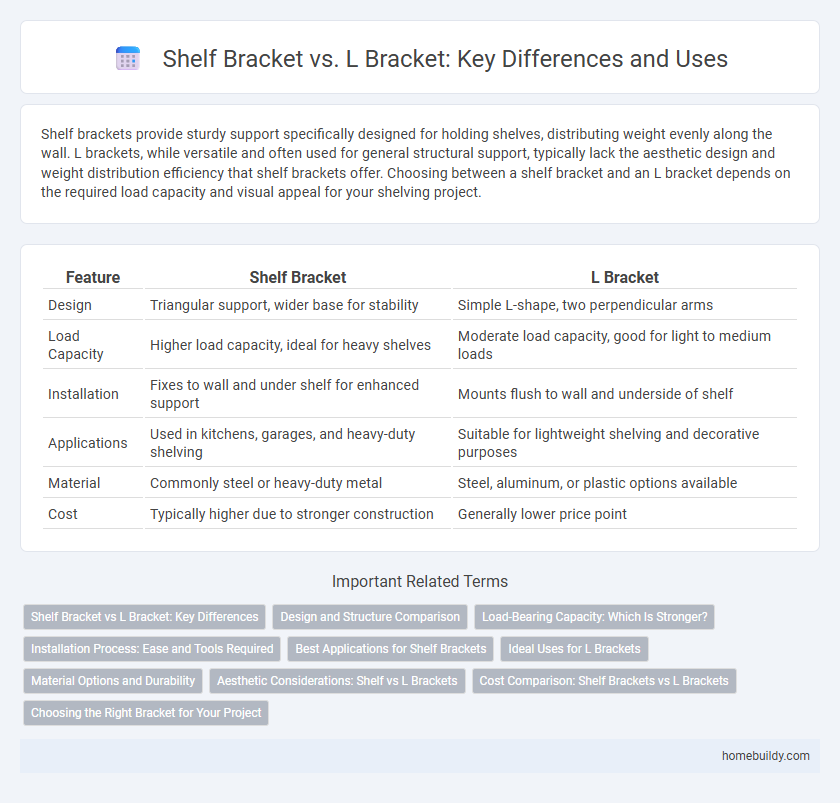Shelf brackets provide sturdy support specifically designed for holding shelves, distributing weight evenly along the wall. L brackets, while versatile and often used for general structural support, typically lack the aesthetic design and weight distribution efficiency that shelf brackets offer. Choosing between a shelf bracket and an L bracket depends on the required load capacity and visual appeal for your shelving project.
Table of Comparison
| Feature | Shelf Bracket | L Bracket |
|---|---|---|
| Design | Triangular support, wider base for stability | Simple L-shape, two perpendicular arms |
| Load Capacity | Higher load capacity, ideal for heavy shelves | Moderate load capacity, good for light to medium loads |
| Installation | Fixes to wall and under shelf for enhanced support | Mounts flush to wall and underside of shelf |
| Applications | Used in kitchens, garages, and heavy-duty shelving | Suitable for lightweight shelving and decorative purposes |
| Material | Commonly steel or heavy-duty metal | Steel, aluminum, or plastic options available |
| Cost | Typically higher due to stronger construction | Generally lower price point |
Shelf Bracket vs L Bracket: Key Differences
Shelf brackets are specifically designed to support shelves with a horizontal arm extending from a vertical support, providing stable load distribution and aesthetic appeal. L brackets, characterized by their simple right-angle shape, are versatile fixtures commonly used for general-purpose corner reinforcement rather than specialized shelf support. Key differences include load capacity, design intent, and installation methods, with shelf brackets typically accommodating heavier weights and offering more decorative options.
Design and Structure Comparison
Shelf brackets feature a horizontal support arm and a vertical mounting plate designed specifically to hold shelves, providing strong load distribution and stability. L brackets offer a simple 90-degree angle structure, primarily serving as general-purpose corner reinforcements but may lack the extended arm needed for optimal shelf support. The design of shelf brackets generally includes additional reinforcements or decorative elements, enhancing both strength and aesthetic appeal compared to the utilitarian form of L brackets.
Load-Bearing Capacity: Which Is Stronger?
Shelf brackets and L brackets differ significantly in load-bearing capacity, with shelf brackets generally designed to support heavier weights due to their extended arm and reinforced diagonal support. Shelf brackets often feature thicker materials and additional gussets, distributing weight more effectively across the wall and shelf compared to the simpler, right-angled L brackets. For applications requiring maximum strength and stability, especially in heavy-duty shelving, shelf brackets provide superior support and durability over L brackets.
Installation Process: Ease and Tools Required
Shelf brackets typically install with simple screws and a drill, requiring minimal tools and offering straightforward alignment for wall mounting. L brackets demand precise measurements to ensure right-angle support, often needing a level, drill, and screwdriver for secure attachment. The ease of installation favors shelf brackets for quick setups, while L brackets provide robust support but may involve a more detailed, time-consuming process.
Best Applications for Shelf Brackets
Shelf brackets excel in supporting longer or heavier shelves, making them ideal for storing books, kitchenware, or heavy tools with enhanced stability. Their design typically includes a flat, continuous support surface that evenly distributes weight, unlike L brackets which provide minimal support limited to corners. For applications requiring sturdy, reliable shelving across larger spans, especially in garages, libraries, or retail displays, shelf brackets are the preferred choice.
Ideal Uses for L Brackets
L brackets are ideal for supporting shelves in corners and tight spaces where sturdy right-angle support is required. They provide strong load-bearing capacity, making them suitable for heavy-duty shelving in garages, workshops, and storage areas. Their compact design also simplifies installation on walls or furniture edges, ensuring stability without occupying excessive space.
Material Options and Durability
Shelf brackets and L brackets differ significantly in material options and durability, with shelf brackets commonly available in steel, aluminum, and heavy-duty plastic, providing enhanced support for heavier loads. L brackets are often made from steel or iron, offering robust durability but with less versatility in design and weight distribution compared to shelf brackets. Steel shelf brackets typically outperform L brackets in resisting bending and corrosion, making them ideal for long-term use in various environments.
Aesthetic Considerations: Shelf vs L Brackets
Shelf brackets typically offer a more streamlined and minimalist aesthetic that complements modern interior designs, while L brackets often have a utilitarian appearance suited for industrial or rustic decor. Shelf brackets come in a variety of decorative styles and finishes, allowing for greater customization in visible support elements. L brackets prioritize functionality over form, making them less visually appealing but highly effective for heavy-duty shelving installations.
Cost Comparison: Shelf Brackets vs L Brackets
Shelf brackets generally offer a cost-effective solution compared to L brackets due to simpler designs and lower material usage. L brackets, often made from thicker metal for enhanced load capacity, tend to incur higher manufacturing and retail prices. Budget-conscious projects favor shelf brackets for affordability without significantly compromising support for lightweight to medium loads.
Choosing the Right Bracket for Your Project
Shelf brackets provide strong, stable support designed specifically for shelving, with features like wider surfaces and reinforced arms ideal for distributing weight evenly. L brackets, typically smaller and simpler, are versatile for light-duty applications but may lack the robustness needed for heavy shelves or extensive load-bearing. Selecting the right bracket depends on factors such as shelf size, weight capacity, material compatibility, and the desired aesthetic, ensuring durability and safety for your project.
Shelf bracket vs L bracket Infographic

 homebuildy.com
homebuildy.com